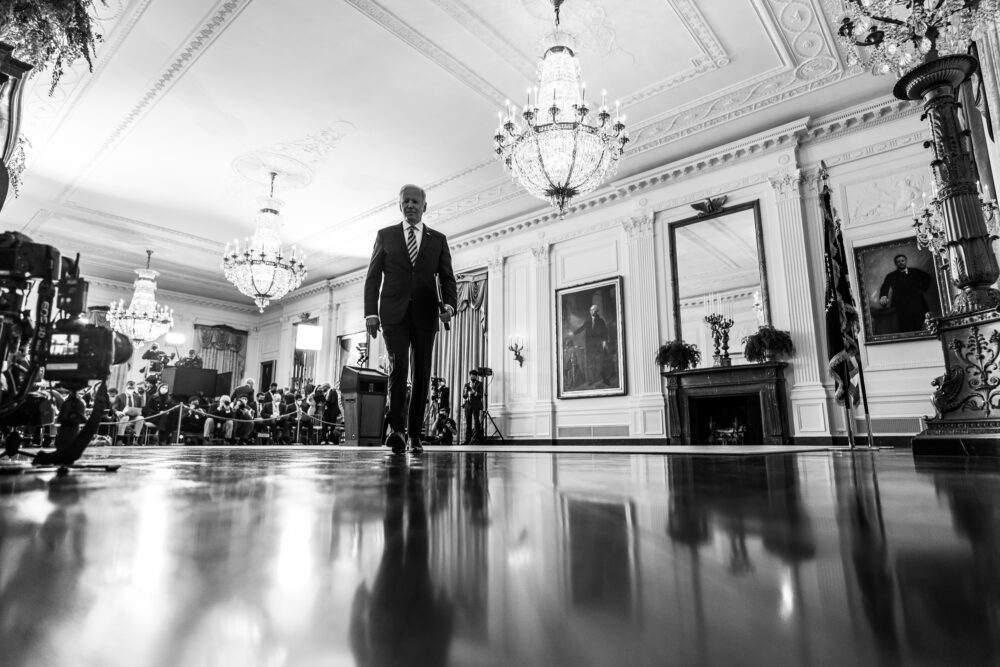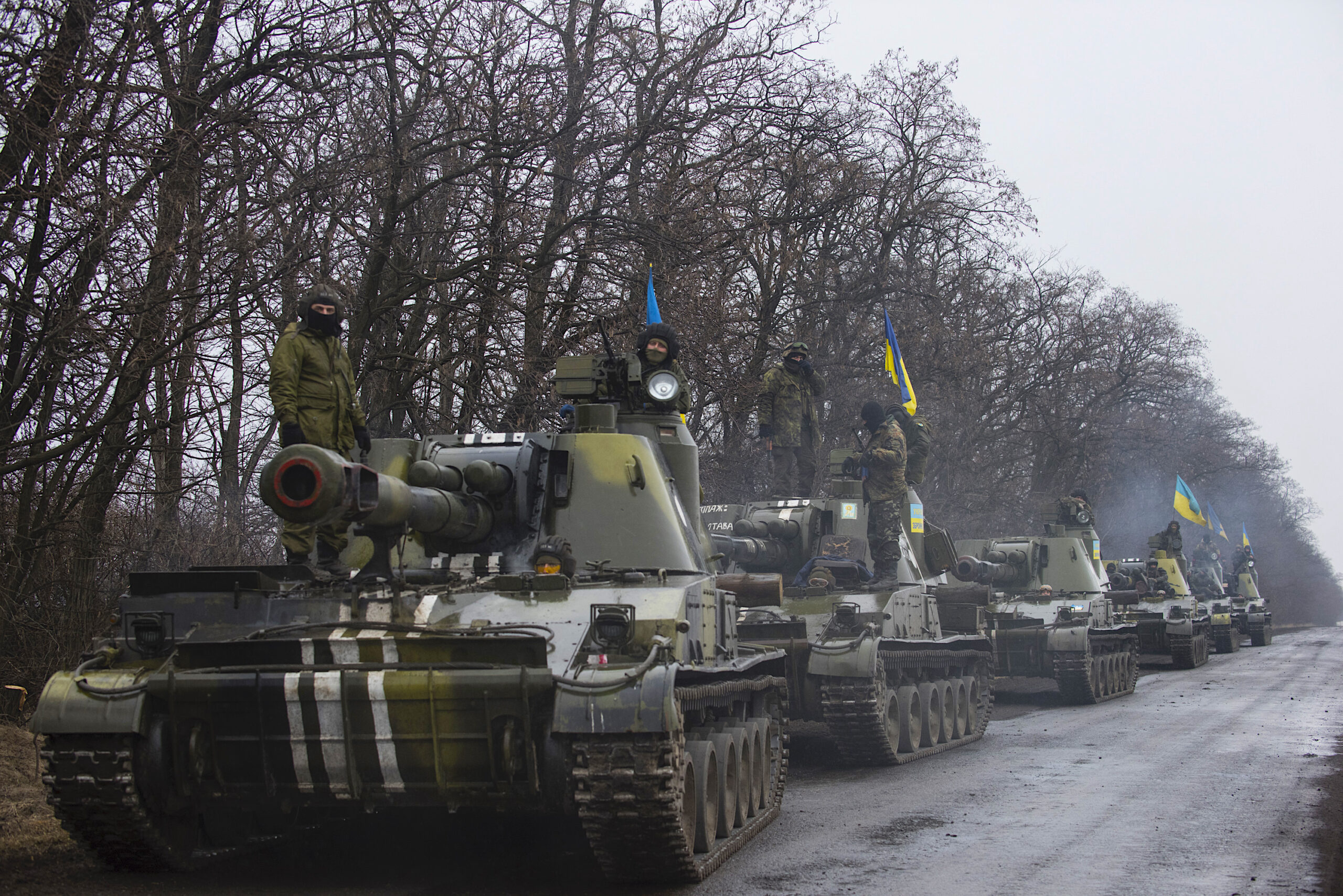US-Laid Trap for Russia Has Trapped West Instead
ANGLO AMERICA, 13 Feb 2023
Joe Lauria | Consortium News – TRANSCEND Media Service
A month before the Feb. 24, 2022 Russian invasion, CN wrote that the U.S. was laying a trap to lure Russia into an economic, information and proxy war. All three have failed for the U.S.

U.S. President Joe Biden after delivering remarks on the Russian invasion of Ukraine, Feb. 24, 2022. (White House, Adam Schultz)
6 Feb 2023 – The U.S.-led West could not launch its economic, information and proxy war against Russia without cause. That cause would be Russia invading Ukraine to defend ethnic Russians in a civil war that had raged since 2014.
The economic war, intended to spur Russians to overthrow their government, has failed spectacularly. The ruble did not collapse despite sanctions on the Russian central bank. Nor has the economy.
Instead an alternative economic, commercial and financial system that excludes the West is rising with China, India and Russia in the lead, and most of Asia, Africa and Latin America taking part. It is the final collapse of Western colonialism. The sanctions instead backfired on the West, especially in Europe.
The information war has failed across the world. Only the United States and Europe, which consider itself “the world,” believe their own “information.”
The proxy war is being lost on the ground, though more than $100 billion in U.S. aid to Ukraine has created a bloodbath. There will either be a negotiated settlement in which Ukraine loses territory; a total Russian victory; or a third world war, potentially the final war.
The U.S. pushed Russia to the brink to provoke its intervention. It began with a 30-year NATO expansion eastward with NATO exercises on Russia’s borders. In December 2021 the West rejected Russian treaty proposals to roll back NATO troop deployments and missile installations in Eastern Europe.
A peace deal to end the 8-year Ukrainian civil war, sparked by the unconstitutional ouster of an elected president in 2014, was endorsed by the U.N. Security Council and was to be implemented under German and French auspices.
But the German and French leaders at the time recently admitted they had no intention of implementing the deal that would have given the ethnic Russian Donbass autonomy, while remaining part of Ukraine.
Instead Angela Merkel and Francois Hollande said Russia was deceived to give NATO time to build up Ukraine’s military to supposedly defend against a Russian invasion. Russia had eight years to invade, but instead pinned its hopes on the Minsk Accords to avoid a larger conflict. When a Western-backed offensive on Donbass began last February, Russia acted.
The West got its larger conflict. On Feb. 4, 2022, 20 days before the Russian invasion, Consortium News laid out the trap being set for Russia, which one year later has trapped the West instead. The quicker it understand this, the better.
The U.S. and NATO are pouring weapons into Ukraine. Kiev says it plans no offensive against Donbass, but if Washington forced one, Moscow would have a major decision to make, writes Joe Lauria.
By Joe Lauria
Special to Consortium News
Feb. 4, 2022
United States plans to weaken Russia by imposing punishing sanctions and bringing world condemnation on Moscow depend on Washington’s hysteria about a Russian invasion of Ukraine actually coming true.
At his press conference on Tuesday, Vladimir Putin said,
“I still believe the United States is not that concerned about Ukraine’s security, though they may think about it on the sidelines. Its main goal is to contain Russia’s development. This is the whole point. In this sense, Ukraine is simply a tool to reach this goal. This can be done in different ways: by drawing us into some armed conflict, or compelling its allies in Europe to impose tough sanctions on us like the US is talking about today.”
At the U.N. Security Council on Monday, Russia’s U.N. envoy Vassily Nebenzia said: “Our Western colleagues say that de-escalation is needed, but they are the first to build up tension, enhance rhetoric and escalate the situation. Talks about an imminent war are provocative per se. It might seem you call for it, want it and wait for it to come, as if you wanted your allegations to come true.”
The war mania being drummed up in U.S. and British media recalls even Zbigniew Brzezinski‘s warning that “whipping up anti-Russian hysteria … could eventually become a self-fulfilling prophecy.”
Without an invasion the U.S. seems lost. No sanctions, no world opprobrium, no weakening of Russia.
If the U.S. is trying to lure Russia into a trap in Ukraine, what might it look like?
Offensive on Donbass
Ukraine says it is not planning an offensive against the breakaway provinces of Luhansk and Donetsk, which border Russia in the east. But just ten days ago Ukrainian President Zelensky said:
❗️President Zelensky speaking to the Foreign Intelligence Service of Ukraine:
“We have learned to contain external threats. It is time we begin offensive actions aimed at securing our national interests. Our citizens are united in wanting their territory returned” pic.twitter.com/iumwOKNEZ5
— Murad Gazdiev (@MuradGazdiev) January 24, 2022
Joe Biden has said a Russian invasion will come in February, when the ground freezes. But it could also be the time for a Kiev offensive to recover the two Donbass provinces. NATO nations are pouring weapons into Ukraine supposedly to defend it against the “invasion.” But the weapons transfers could instead be preparation for an offensive, on orders from Washington. The U.S. essentially runs the country since the 2014 U.S.-backed coup, which led the ethnic Russian provinces to declare independence from Ukraine and led to Kiev’s war against them. All Ukrainian leaders, including Zelensky, serve at the pleasure of the U.S. president.
The ground will also be frozen for Kiev’s forces in February, which was the month of the 2014 coup, while Putin was in Sochi for the Winter Olympics. He is now in Beijing for the 2022 Winter Olympics, away from the command center in Moscow. (The 2008 Summer Olympics in Beijing was also the time Georgia instigated its war with Russia against its renegade provinces at the behest of the United States.)
When Kiev stepped up attacks against Donbass in March and October 2021, Russia both times increased its troop deployments near the Ukraine border, which this time is being interpreted by Washington as plans for an “imminent” invasion.
It is an invasion the U.S. absolutely needs to implement its plans to weaken Russia (and ultimately to replace Putin with a pliable leader in the mold of Boris Yeltsin.) As Moscow has never openly threatened such an invasion, the U.S. appears to be devising ways to get it.
The Russian ‘Plot’
On Thursday U.S. intelligence leaked what it says is a diabolical scheme by Russia to stage a provocation in Donbass or even on Russian territory itself to provide a pretext for an invasion. The New York Times reported the lurid details of this supposed plot:
“The plan — which the United States hopes to spoil by making public — involves staging and filming a fabricated attack by the Ukrainian military either on Russian territory or against Russian-speaking people in eastern Ukraine.
Russia, the officials said, intended to use the video to accuse Ukraine of genocide against Russian-speaking people. It would then use the outrage over the video to justify an attack or have separatist leaders in the Donbas region of eastern Ukraine invite a Russian intervention.
The video was intended to be elaborate, officials said, with plans for graphic images of the staged, corpse-strewn aftermath of an explosion and footage of destroyed locations. They said the video was also set to include faked Ukrainian military equipment, Turkish-made drones and actors playing Russian-speaking mourners.”
Of course unsaid is that the U.S. can get Kiev to launch an actual attack, even inside Russia, and then say it was the false flag event, to try to prompt the Russian intervention.
As usual, the U.S. “intelligence officials” refused to provide any evidence for such a plot. “Officials would not release any direct evidence of the Russian plan or specify how they learned of it, saying to do so would compromise their sources and methods,” the Times reported.
That prompted AP State Department correspondent Matt Lee to have this exchange with spokesman Ned Price on Thursday. Because Price was unable to produce any evidence he resorted to smearing Lee as taking “solace” in Russian information.
Reporter: “It’s an action that you say they have taken, but you have shown no evidence to confirm that. […] This is like – crisis actors? Really? This is like Alex Jones territory you’re getting into now.”
Must-watch exchange between @APDiploWriter Matt Lee and @StateDeptSpox. pic.twitter.com/RPIPb2zwf5
— The Hill (@thehill) February 3, 2022
Price responded: "If you doubt the credibility of the U.S. government, of the British government, of other governments and want to, you know, find solace in information that the Russians are putting out, that is for you to do." 5/x
— Felicia Sonmez (@feliciasonmez) February 3, 2022
So if the offensive comes this month, with or without a false flag, how will Russia respond?
Options for Russia
If a major offensive attempts to regain Donbass (likely downplayed by Western media) there’s no reason to doubt Russia would continue supplying arms, ammunition, intelligence and logistical support to the militias there.
However if those defenses begin failing, the Kremlin would have a major decision to make: intervene with regular Russian units to save the inhabitants, most of whom are Russian-speakers, or abandon them to avoid giving Washington the invasion it seeks to prompt the harsh U.S. response.
If Russia did not intervene it would see massive refugees, destruction of the Minsk agreements that would give Donbass autonomy, and a hostile Ukrainian force at its borders. Putin would also have hell to pay from the Duma that has been moving legislation to annex the provinces to Russia, a move resisted so far by Putin. If they became part of Russia, Moscow would argue it was no invasion at all.
Political analyst Alexander Mercouris told CN Live! on Wednesday that he thought an offensive unlikely because of the low morale of senior Ukrainian military. But, he said:
“If there were an offensive in eastern Ukraine, Russia would back the militia … and if there were a chance of a Ukrainian breakthrough, I think the Russians would respond, and respond decisively. I don’t think this is speculation. If you look at the statements that Russian officials have made, including by [Foreign Minister Sergei] Lavrov, including to a great extent Putin himself, I think it’s absolutely clear what the Russian response would be.”
But that, as long as Donbass remains part of Ukraine, would be the invasion Washington has been screaming about and much of the world has been prepared to believe is about to happen. And it would mean that Russia had taken the bait and fallen into the U.S. trap.
Precedents for a Trap

April 18,1991: Demolished vehicles line Highway 80, also known as the “Highway of Death”, the route fleeing Iraqi forces took as they retreated fom Kuwait during Operation Desert Storm. (Joe Coleman,/Air Force Magazine,/Wikimedia Commons)
There are precedents for this. One is the clear signal given to Iraqi dictator Saddam Hussein by April Glaspie, the U.S. ambassador to Iraq, in 1990 that the U.S. would do nothing to stop him from invading Kuwait. She told Saddam that the U.S. had no “opinion on the Arab-Arab conflicts, like your border disagreement with Kuwait.” But it wasn’t just Glaspie that left the door open to Kuwait. The Washington Post reported on Sept. 17, 1990:
“In the same week that Ambassador April Glaspie met a menacing tirade from Saddam with respectful and sympathetic responses, Secretary of State James Baker’s top public affairs aide, Margaret Tutwiler, and his chief assistant for the Middle East, John Kelly, both publicly said that the United States was not obligated to come to Kuwait’s aid if the emirate were attacked. They also failed to voice clear support for Kuwait’s territorial integrity in the face of Saddam’s threats.”
Following the 1979 Islamist revolution in Teheran that overthrew the U.S.-backed Shah, the United States sought to contain Iran by supplying billions of dollars in aid, intelligence, dual-use technology and training to Iraq, which invaded Iran in 1980, spurring an eight-year long brutal war. The devastating conflict ended in a virtual stalemate in 1988 after the loss of one to two million people.
Though neither side won the war, Saddam’s military remained strong enough to be a menace to U.S. interests in the region. The trap was to allow Saddam to invade Kuwait to give the U.S. a reason to destroy Iraq’s military. For instance, retreating Iraqi soldiers were essentially shot in the back in the massacre on the Highway of Death.
The ‘Afghan Trap’
Another U.S. trap was to lure the Soviet Union into Afghanistan in 1979. In a 1998 interview with Le Nouvel Observateur, Brzezinski admitted that the C.I.A. essentially set a trap for Moscow by arming mujahiddin to fight the Soviet-backed government in Kabul. He said:
“According to the official version of history, CIA aid to the Mujahiddin began during 1980, that is to say, after the Soviet army invaded Afghanistan on December 24, 1979. But the reality, closely guarded until now, is completely otherwise: Indeed, it was July 3, 1979 that President Carter signed the first directive for secret aid to the opponents of the pro-Soviet regime in Kabul. And that very day, I wrote a note to the president in which I explained to him that in my opinion this aid was going to induce a Soviet military intervention.
He then explained that the reason for the trap was to bring down the Soviet Union, (much as the U.S. today would like to bring down Putin’s Russia.) Brzezinski said:
“That secret operation was an excellent idea. It had the effect of drawing the Russians into the Afghan trap and you want me to regret it? The day that the Soviets officially crossed the border, I wrote to President Carter, essentially: ‘We now have the opportunity of giving to the USSR its Vietnam war.’ Indeed, for almost 10 years, Moscow had to carry on a war that was unsustainable for the regime, a conflict that bought about the demoralization and finally the breakup of the Soviet empire.”
Brzezinski said he also had no regrets that financing the mujahideen spawned terrorist groups like al-Qaeda. “What is more important in world history? The Taliban or the collapse of the Soviet empire? Some agitated Moslems or the liberation of Central Europe and the end of the cold war?,” he asked.
So if the U.S. is setting a similar trap in Ukraine for Moscow, will it work?
“I think the Russians are smarter than Saddam,” said military analyst Scott Ritter. “Any Ukrainian incursion into Donbass would be handled by the pro-Russian militias, backed by Russian forces. I don’t think Russia would move on Ukraine unless NATO membership was invoked.”
It remains to be seen whether Russia steps into a U.S. bear trap in Ukraine.
____________________________________________
 Joe Lauria is editor-in-chief of Consortium News and a former correspondent for The Wall Street Journal, Boston Globe and numerous other newspapers, including The Montreal Gazette and The Star of Johannesburg. He was an investigative reporter for the Sunday Times of London, a financial reporter for Bloomberg News and began his professional work as a 19-year old stringer for The New York Times. Email: joelauria@consortiumnews.com
Joe Lauria is editor-in-chief of Consortium News and a former correspondent for The Wall Street Journal, Boston Globe and numerous other newspapers, including The Montreal Gazette and The Star of Johannesburg. He was an investigative reporter for the Sunday Times of London, a financial reporter for Bloomberg News and began his professional work as a 19-year old stringer for The New York Times. Email: joelauria@consortiumnews.com
Go to Original – consortiumnews.com
Tags: Balkans, Bullying, Eastern Europe, European Union, Hegemony, Imperialism, Pentagon, Proxy War, Russia, USA, Ukraine, Warfare, West
DISCLAIMER: The statements, views and opinions expressed in pieces republished here are solely those of the authors and do not necessarily represent those of TMS. In accordance with title 17 U.S.C. section 107, this material is distributed without profit to those who have expressed a prior interest in receiving the included information for research and educational purposes. TMS has no affiliation whatsoever with the originator of this article nor is TMS endorsed or sponsored by the originator. “GO TO ORIGINAL” links are provided as a convenience to our readers and allow for verification of authenticity. However, as originating pages are often updated by their originating host sites, the versions posted may not match the versions our readers view when clicking the “GO TO ORIGINAL” links. This site contains copyrighted material the use of which has not always been specifically authorized by the copyright owner. We are making such material available in our efforts to advance understanding of environmental, political, human rights, economic, democracy, scientific, and social justice issues, etc. We believe this constitutes a ‘fair use’ of any such copyrighted material as provided for in section 107 of the US Copyright Law. In accordance with Title 17 U.S.C. Section 107, the material on this site is distributed without profit to those who have expressed a prior interest in receiving the included information for research and educational purposes. For more information go to: http://www.law.cornell.edu/uscode/17/107.shtml. If you wish to use copyrighted material from this site for purposes of your own that go beyond ‘fair use’, you must obtain permission from the copyright owner.

